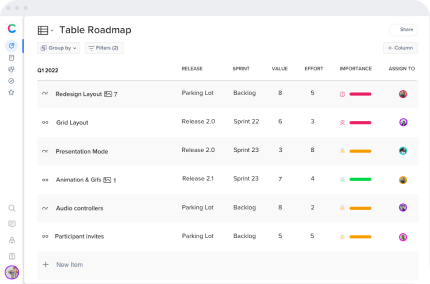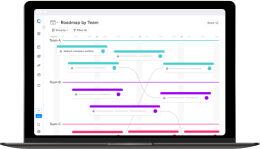What is business agility?
Business agility (BA) is all about helping your organization move fast and stay competitive in a constantly changing digital world. Business agility is the ability to quickly and effectively adapt to change and opportunities by building innovative, connected business solutions.
Achieving this isn’t just the job of product teams, it’s a company-wide effort. Leaders, developers, IT, marketing, finance, legal, support, and more all need to work in sync, using Lean and Agile practices to deliver high-quality products and services faster than the competition.
Why business agility is essential in today’s digital economy
When properly implemented, business agility accomplishes precisely what it says on the tin – it makes a company more agile.
This indicates that a company is prepared to adapt to internal and external changes, respond quickly and efficiently to the demands and aspirations of its customers, and be on the cutting edge of innovation and adaptation without incurring excessive expenditures or compromising quality, among other things.
Because it will be able to adapt more quickly than its competitors, an agile business, built on agile values, will maintain a competitive advantage in the marketplace. However, not only will it be more responsive than its competitors, but it will also be more informed, innovative, and responsive to the needs of its clients.
Customer centricity
Listening to, empathizing with, and servicing customers’ requirements as rapidly as possible—is at the heart of business agility.
Businesses are doing the right thing by their customers and making themselves more appealing to potential customers. Agile companies quickly discover their flaws and errors before correcting them and providing better user experiences.
The Benefits of Business Agility
When used correctly, business agility creates real value for organizations and delivers long-term impact. At its core, the meaning of business agility is the ability of a company to adapt quickly, respond to opportunities, and stay focused on customer needs. This flexibility is what sets agile businesses apart from more rigid, traditional organizations.
Turning challenges into opportunities
Businesses that embrace business agility can adapt more easily to risks and opportunities in the market while keeping customers at the center. Unlike more rigid organizations, they are not tied down by long-term plans and strategies, which allows them to adjust quickly as conditions change.
The advantage in the marketplace
Agile organizations can seize short-term opportunities, allowing them to be first to market. They can learn from their mistakes and defeats, reroute their paths rapidly, and abandon their plans. They may also confidently react in advance to stay up with (or outpace) the competition.
Collaboration between departments
Because of the cross-pollination of ideas and the enabling atmosphere, business agility can also break down organizational silos and stimulate creativity and inventive problem-solving. This collaboration often depends on roles like the Agile Product Owner, who bridges business needs and product delivery.
Benefits for everyone
All stakeholders who operate in unpredictable, complicated, and ambiguous settings benefit from agility in an organization’s culture, leadership, strategy, and governance.
FurtherMore – Businesses can benefit from business agility because it extends the mindset that underpins agile development to every aspect of their operations. Skill has a lot of commercial advantages, including being able to get products to market faster and being more adaptable to changing conditions.
Streamline organizational procedures
Most importantly, business agility helps streamline organizational procedures, allowing for cost savings while maintaining high levels of quality.
It accomplishes this by ensuring that brief and cost-effective development sequences allow for a continuous cycle of change and improvement for new products. In contrast to Agile development, where flexibility and adaptability are applied to short-term projects, business agility involves these ideas throughout an organization, allowing every department to benefit.
How Business Agility Works in Practice
Many organizations believe they are agile because their product development teams operate according to agile principles. But what is business agility really? The business agility definition goes far beyond agile frameworks. It is a company-wide mindset and strategy that touches leadership, culture, processes, and decision-making.
The Business Agility Framework
Building business agility means turning strategy, culture, and execution into one connected system. It is about giving teams the structure and freedom they need to deliver customer value fast without losing focus or quality.
A simple framework helps organizations bring business agility to life across all levels.
- Strategic Business Agility
Define a clear product vision, stay close to customer needs, and adapt plans as priorities change. - Empowered Culture
Build trust, encourage learning, and give teams the confidence to make decisions that move work forward. - Fast Value Delivery
Form cross-functional teams that deliver improvements in short, measurable cycles. - Smart Governance
Keep processes simple and funding flexible to maintain speed and focus. - Resilience and Adaptability
Create systems and teams that recover quickly, learn continuously, and keep improving.
Together, these pillars help product-led organizations move faster, stay aligned, and deliver consistent customer value.
What does agility mean in business?
In practice, business agility meaning flexibility and fluidity. Teams and employees can move smoothly between priorities, and resources are available where they are needed most. True agility is not just about short-term projects but about enabling the entire organization to adapt quickly.
To put business agility into action:
- Empower self-organizing teams to respond quickly to new opportunities or challenges.
- Encourage flexibility so people and resources can shift seamlessly to where they add the most value.
- Build trust and empowerment, giving teams the freedom to use creativity and judgment in their decisions.
- Put strong foundations in place with governance, processes, and infrastructure that support agility at scale.
These practices unlock real business agility benefits: faster response, better alignment, more innovation, and sustained value across the organization. Supporting this approach often requires the right digital solutions, and there are many helpful Agile project management tools that make it easier for teams to stay adaptive and customer-focused.
Typical obstacles to company agility
Getting people on board with business agility can be difficult. Most organizations thrive on predictability, so shifting to a more uncertain, flexible, and faster-paced way of working may feel counterintuitive or even upsetting.
Removing control, approval, and decision-making authority from the C-Suite is also a challenge. Senior management often struggles with delegating responsibility and finding the right balance between independence and oversight.
Business agility can sometimes foster short-term thinking by prioritizing rapid reactions over long-term goals. Without careful management, it may also leave a company stuck in a reactive mindset, constantly responding to issues as they appear.
Studies show that fear, overconfidence, and ego are major roadblocks to agility. For many leaders, the idea of losing control is daunting, and without a clear long-term vision, performance can suffer.
Yet remaining rigid is no longer a guarantee of success. Organizations that embrace agility, despite these challenges, unlock valuable opportunities for resilience, speed, and growth.
Start your journey to business agility
Business agility is more than a set of practices. It is a mindset that helps organizations adapt, innovate, and deliver real value in a world that is always changing. Building this capability takes teamwork, focus, and a willingness to learn and improve together.
Your journey does not need to be perfect from the beginning. Start small, experiment, listen to feedback, and keep moving forward. With the right practices and alignment across your teams, you will build the speed, flexibility, and customer focus needed to thrive. Business agility is not a final destination. It is the way to keep growing, creating, and succeeding.
FAQs
What is meant by business agility?
Business agility is the ability of a company to adapt quickly to change, respond to customer needs, and take advantage of new opportunities. It means being flexible, innovative, and fast in the way the entire organization works. This includes every team, not only product teams, so the business can stay competitive and continuously deliver value.
What is an example of business agility?
An example of business agility is when a company uses business intelligence tools to quickly spot challenges and opportunities, then adapts its plans in real time. For instance, product teams can update priorities based on live customer feedback, helping them respond faster to market shifts and deliver greater value.
How do you measure success in business agility?
Success in business agility is reflected in how quickly an organization can turn ideas into customer value. Companies that apply the Business Agility Framework often see faster time to market, higher customer satisfaction, stronger team engagement, and improved adaptability. For example, a team practicing strategic and operational business agility might release a new product iteration within weeks instead of months, using real-time feedback to guide improvements and deliver continuous value.
What are the three A’s of business agility?
The three A’s of business agility are Awareness, Adaptability, and Action. Awareness means spotting changes, risks, or opportunities early. Adaptability is the ability to adjust strategies and priorities quickly. Action is about taking decisive steps to deliver value. Together, these three A’s keep organizations flexible, resilient, and focused on customer needs.


